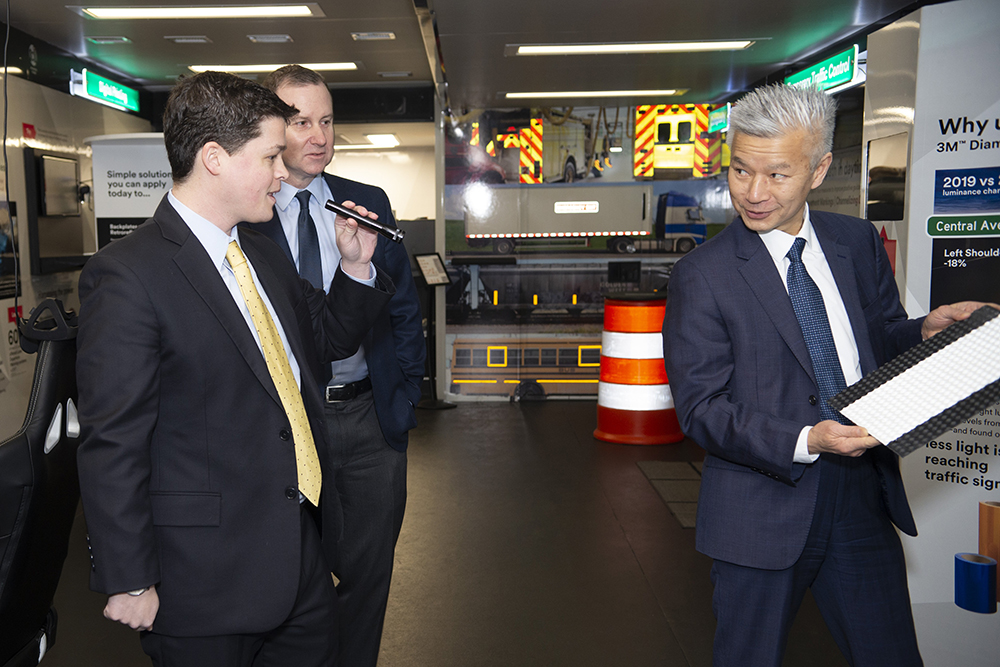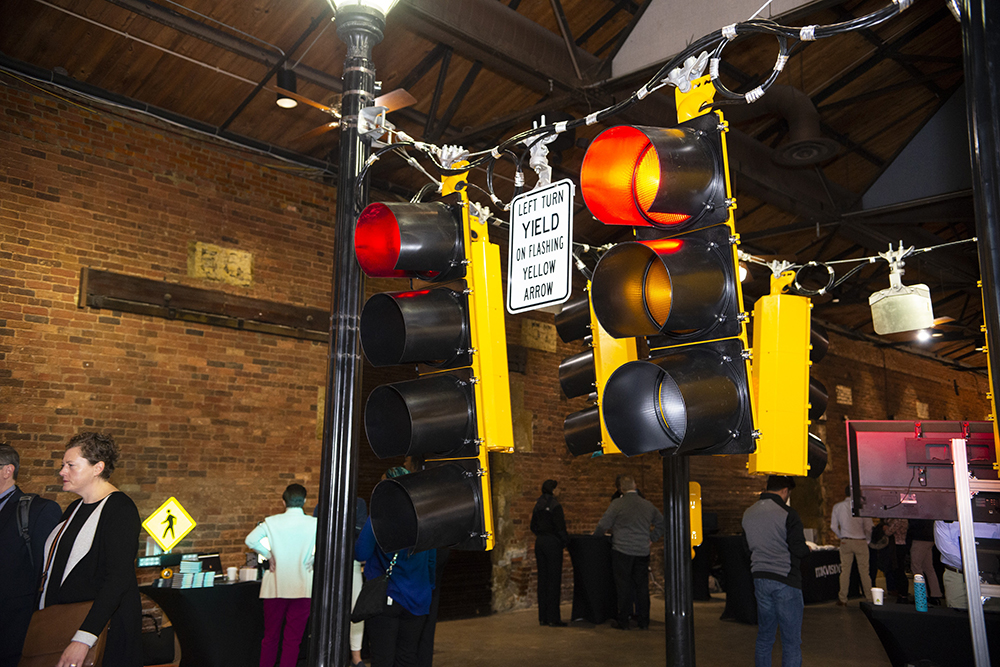
Connected vehicle (CV) technology has less the ring of science fiction these days and feels more like part of the here and now. Tech which has the potential to improve safety, reduce commuting times and enhance traffic management sounds just like the sort of thing local transport officials see in their dreams.
It helps that big-name auto manufacturers such as Ford Motor Company have publicly thrown their hats into the ring, announcing plans to fit CV tech in its vehicles from 2022, but local authorities need to start getting ready for it now if they are going to take advantage.
The Georgia Department of Transportation (GDoT) has been quick off the mark, calling for private contractors to come forward with a turnkey CV solution for principal roadways in Metro Atlanta. More than 400 locations across the area are already connected with dedicated short-range communications (DSRC) – but the plan is that the new contractor will provide 1,000 more which will deploy both DSRC and cellular-Vehicle to Everything (C-V2X) solutions.
This extra 1,000 is the bedrock of the Regional Connected Vehicle partnership between GDoT and the Atlanta Regional Commission (ARC), announced in January by Georgia governor Brian Kemp. The initial phase will cost $10 million - $8m from federal sources and $2m from local governments and Community Improvement Districts.

GDoT has been in discussions with Ford, whose head of CV technology, Jovan Zagajac, is enthused: “The efforts underway in Georgia will place them at the front of the line in realising the safety and mobility benefits that CV technology can provide.”
New ideas
A recent Tech Showcase indicated Georgia’s embrace of new ideas (see box), and the state is certainly well-developed when it comes to CV infrastructure. “Probably we’ve jumped the curve,” John Orr, manager of ARC’s transportation access group, tells ITS International.
ARC is the regional planning agency, taking in 20 counties including the city of Atlanta, and saw gaps in the way bus transit and emergency vehicle access, in particular, were being dealt with.
“Over a period of eight months we identified an opportunity to address critical needs in the region: we need to encourage signal transit priority for buses and emergency vehicle pre-emption,” Orr says. “A major objective is to increase transit use for our region. Buses are often caught in traffic jams which leads to unreliability.”
This means that people are discouraged from using them, creating a vicious circle. But if buses and ambulances were equipped with on-board units it would be a different story.
“We felt CV technology could address it,” says Orr. “For emergency vehicles it is a huge issue: saving even a minute in emergency response times can save lives.” Delays and even crashes in heavy traffic should be avoided with the right tech in place – indeed, the Tech Showcase demonstrated how emergency vehicle pre-emption at traffic lights can enhance safety by allowing those vehicles to arrive at their destinations up to 30% faster.
CV technology will not just be getting cars to talk to each other, either. “How do we better connect information on pedestrians and cyclists with cars and vice versa?” asks Orr. “At the national level there is a lot of research on methods to allow pedestrians to communicate their positions via cell phones to vehicles.”
For the Georgia CV programme, a working team including ARC and the metropolitan planning organisation took shape to consider the best way forward. “We collaborated with the private sector and local government, and looked at various options,” says Orr. “GDoT are doing the hard part of implementation: they’re definitely going to carry the ball on that.”
Major player
“It’s very complicated,” Andrew Heath, GDoT state traffic engineer, tells ITS International. “We’re reaching out to other sectors that we have not traditionally done, like auto manufacturers such as Toyota or Ford. We’re the infrastructure owner/operator. This means primarily that we’re the major player – but we need to understand from the industry as a whole: what do you need from us and what do you need us to do to empower this technology?”
GDoT expects to have a single contractor on board by the end of this year to carry out the CV work, “from nothing to everything”, as Heath puts it. “It’s a new, relatively complex technology. Part of it is the education factor, as well: we need to be in the middle of this as a DoT – but there are a lot of folks on the periphery too.”
The message to them is straightforward, Heath says: “It’s a real thing that exists: here’s the technology, here’s how it works, here’s why interoperability is important. There is a need for a continual educational effort because the knowledge base – at least right now – is frankly not there.”

The appeal of this roll-out is, therefore, to showcase the CV tech in a tangible way, “drawing attention to its power, to the positive impacts”.
Heath reckons that 1,000 locations should be up and running by 2022. “It’s an incremental deployment but structured to be an ongoing programme.” The hope is that other local partners will come on board as they see what’s happening. In Metro Atlanta, it is anticipated that all intersections could be connected in up to five years.
The Atlanta area understandably sucks in a lot of money and effort. “The reality is that Metro Atlanta is a massive piece of Georgia from a transportation and population perspective,” confirms Heath. But he insists that there is a desire to roll out the idea to other metropolitan areas such as Savannah, Columbus and Augusta in time.
Regulatory future
Countryside roads are also on the agenda: Heath points to a pilot project with Panasonic which is installing roadside units on an 18-mile stretch of rural interstate in a bid to see whether it helps drivers to receive extra information. “These are initial steps to get our feet wet but it’s a natural progression,” he says.
“The biggest challenge has been dealing with uncertainty in regulation,” Orr continues. The Federal Communications Commission (FCC) has dismayed ITS practitioners with its suggestion that the 5.9GHz band could be opened up to activities which have nothing to do with road safety. “A lot of these discussions have been conducted at GDoT level,” Orr continues. “There is a challenge to accommodate these two technologies – DSRC and C-V2X – and how to include future technologies.”
The regulatory future is uncertain, but Orr insists: “Preserving the band for transportation safety ultimately trumps any other consideration because it is a public health issue.”
Heath is also concerned. “Right now, 75MHz of radio bandwidth has been dedicated by the FCC for transportation safety and that’s been in place for 20 years,” he explains. Under the new FCC proposals that may shrink to 30MHz – 20 of which would be specifically for C-V2X, and the remaining 10 for C-V2X or DSRC. “The concern we have is the adequacy of 30MHz. Is that enough? We’re also concerned about the potential interference from leakage from the unlicensed spectrum. We’d like the full 75MHz to be retained.”
That is something over which the ITS industry does not have control – but it can decide how to use the technology available, and the bottom line for Georgia’s CV programme is the safety aspect. “When you hear it can mean an 80% reduction in crashes, your ears prick up,” concludes Heath. “You think: ‘how do I do that?’”
GDoT Tech Showcase
The Georgia Department of Transportation (GDoT) partnered with more than 20 transportation technology companies to create its first Tech Showcase. This inaugural programme, sponsored by the Intelligent Transportation Society of Georgia and Georgia Institute of Transportation Engineers, was designed to show off how the state is working with the private sector to improve transport connectivity.
“In this new decade, we will redefine what we think of as mobility,” said GDoT commissioner Russell McMurry. “New technologies for everything from on-road communications to data analysis will not only dramatically change how vehicles operate, but also provide information and capabilities for better, real-time traffic management.”

Among the ideas on show were existing and potential technologies to improve traffic flow, reduce crashes and delays - and alert motorists to traffic signal status via vehicle-equipped mobile devices and in-car displays. There was also an emphasis on enhancements to crosswalks to increase pedestrian safety by integrating the crosswalk system with connected vehicle-ready infrastructure.
Visitors were also shown how technology can turn existing highway cameras into intelligent sensors to measure speeds and detect stopped vehicles, people or things in the road.
But McMurry warned that the benefits “can only be achieved if the necessary network infrastructure is in place”.
Building relationships
“GDoT is leveraging innovative strategies to enhance transportation that helps improve the quality of life of hard-working Georgians in all parts of our state,” said Georgia governor Brian Kemp. “We work hard to continue to bring private and public sectors together to build relationships.”
Other demos at the Tech Showcase included how Vehicle to Infrastructure solutions can reduce collisions by allowing automatic control of signal timing, speed management, plus the operation of emergency, transit and commercial vehicles. There was also a look at MARTA bus Transit Signal Priority’s works to allow a smoother run for buses and how connected vehicle technology can allow trucks to request green lights on designated corridors in off-peak periods.
Thermal imaging to detect and alert drivers about wrong-way vehicles was also on show, as was GDoT’s use of intelligent automation to more quickly locate motorists calling in an incident to 511 or 911 - and how the maintenance department can use it to identify trees and power lines which have been downed by bad weather. Existing roadway weather information system (RWIS) data can feed variable message boards and flashing beacons, while the HERO and CHAMP roadside assistance programmes use technology to clear incidents, provide fleet tracking and give advance warning to drivers approaching an incident.
“Many of these technologies are being tested or are already in use in Georgia,” GDoT suggests. “And while not every Tech Showcase solution will find its way to the state’s roads, they are examples of GDoT’s commitment to embrace new technologies for the betterment of Georgia.”
Get connected: iATL opens
In January, the 4,400 sq ft Infrastructure-Automotive Technology Laboratory (iATL) opened in Alpharetta, Georgia. Sponsored by Applied Information, it is designed to bring together automakers, cellular network operators, traffic control device companies and semiconductor manufacturers in a single technology hub to create, develop and test CV safety applications.
 “The ability of vehicles to communicate with the traffic control infrastructure is crucial to improving roadway safety and for the rapid adoption of CV technology across the fleet,” said Ford’s Jovan Zagajac.
“The ability of vehicles to communicate with the traffic control infrastructure is crucial to improving roadway safety and for the rapid adoption of CV technology across the fleet,” said Ford’s Jovan Zagajac.
Manufacturers can test safety applications in real-world conditions in the streets of Alpharetta, which operates the first large-scale deployment of CV infrastructure technology using all forms of communications simultaneously – 4G LTE, C-V2X, DSRC) and 900 MHz radio, underwritten by the North Fulton Community Improvement District.
“The iATL is not just a collection of traffic devices in a laboratory, but it is embedded in an ecosystem of 125 connected intersections to test the Day One applications in real-world conditions,” said Bryan Mulligan, president of Applied Information.
The facility houses various electronic devices that control everything from traffic signals to school zone safety beacons to electronic crosswalks. Automakers will be able to develop interactive safety apps that interact with the devices and cellular network operators will work out communications including 5G, the organiser says.












